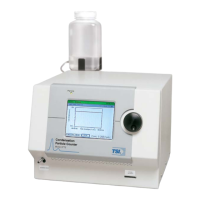5-4 Model 3775 Condensation Particle Counter
The 3772/3771 CPC uses n-butyl alcohol as the working fluid and
an external vacuum pump or source to drive the 1 L/min aerosol
flow rate. The 3782 WCPC uses water as the working fluid and uses
an internal vacuum pump to drive the 0.6 L/min aerosol flow. Both
3772/3771 and 3782 can detect 10 nm particles at 50% detection
efficiency. The 3782 can also be set to have a D
50
of 20 nm.
For high-concentration measurements, a classical photometric
light-scattering technique is used. The first commercial version of
this type of CNC (TSI Model 3020) used n-butyl alcohol as the
condensing fluid and has a flow rate of 0.3 L/min. TSI’s Model 3020
CNC was replaced in 1988 by the Model 3022A, which was replaced
again in 2005 by the Model 3775 CPC. Both the Model 3775 CPC
and the 3785 WCPC use the photometric mode of operation to
monitor high particle concentrations up to 10
7
particles/cm
3
. These
CPCs are general-purpose instruments suitable for a wide variety of
applications.
The Model 3025 Ultrafine Condensation Particle Counter (UCPC)
was developed in 1989 and was replaced by the Model 3776 UCPC
in 2005. The 3776 has a lower size detection limit and a higher
aerosol flow rate compared to the 3025A. Both the 3776 UCPC and
3786 UWCPC utilize sheath-air-flow design to lower the size
detection limit. When growing the particles in the condenser
chamber, the highest saturation ratio occurs on the centerline of
the flow stream at some distance down the condensing tube
(Stolzenburg [1988]). Although the saturation ratio is not uniform
across the flow profile due to thermal gradients, the lower size-
sensitivity can still be predicted and measured. Using sheath air,
the CPC confines the aerosol to the centerline of the condenser tube
where level of supersaturation is the highest. The result is very high
detection efficiency for small particles. The high sensitivity of the
Model 3776 UCPC and the Model 3786 UWCPC makes them the
only instruments of their kind that can detect particulates down to
2.5 nm. This makes them useful for atmospheric studies,
nucleation, cleanroom monitoring, and basic aerosol research, etc.
The sheath-air-flow design of the two CPCs also significantly
reduces the response time for particle detection and particle
diffusion losses. This occurs because aerosol particles are routed
directly from the inlet to the condenser and optics, not through the
saturator.
The Model 3781 WCPC is a small size and light weight instrument
that detects particles down to 6 nm and operates in single count
mode for concentration up to 5 × 10
5
particles/cm
3
.
The Model 3007 CPC was developed in 2001. It is a hand-held,
battery powered instrument with a size detection limit of 10 nm. It
uses isopropyl alcohol as the working fluid.

